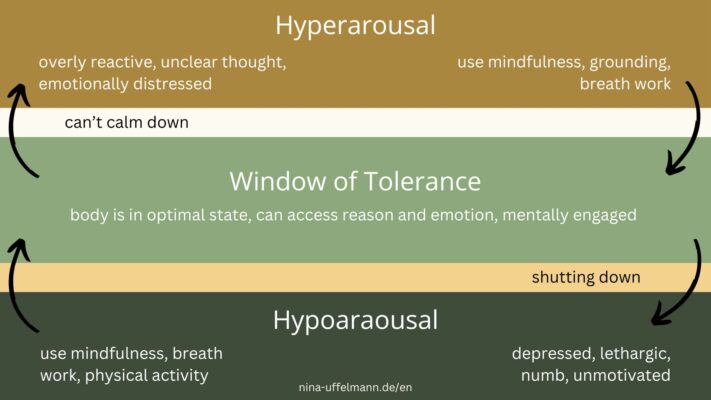The window of tolerance
In psychology, there is a concept called the Window of Tolerance, which I recently learnt about in a supervision session. The Window of Tolerance refers to our mental state. The concept describes the range within which a person is able to cope with stress and challenges appropriately, without falling into extreme reactions such as hyperarousal or freezing.
The best way to visualise the Window of Tolerance is as a river, flowing calmly and steadily, on which you can float and function effectively. When you are within this window, you are able to regulate your thoughts and emotions, deal with stress and respond appropriately to the demands of your environment, access reason and emotions and be mentally present.

When you get into an hyperaroused state outside of your Windows of Tolerance, you show increased reactivity. In this state, most people feel very anxious, angry or out of control and feel the need to fight or flight. Usually you don't go seamlessly from your window of tolerance to overexcitement - there is a borderline area in between. In this area, you initially feel tense, you start to feel angry or anxious. You don't feel comfortable in this transitional area, but you don't feel out of control yet. If you enter this borderline area and are not able to recognise this and successfully regulate yourself, you will end up in the hyperaroused state described above.
If you find yourself in a strongly hypoaroused, rigid state instead, you can feel lethargic, listless, depressed, (emotionally) numb and lacking in motivation. Here, you find it difficult to do the things that are actually important to you; there is a reduced reactivity. As you approach the borderline of freezing, you start to feel overwhelmed, your body may start to shut down and you may lose track of time. Here, too, you don't feel well, but you are not yet out of control, and here, too, it is important to recognise your condition and regulate yourself successfully so that you don't end up in a hypoaroused state.
The window of tolerance can change
Various factors can influence the window of tolerance. Let's imagine the river again. Things like your current stress level, sleep, diet or social support can cause the riverbed to become much narrower, the river to flow faster, and you to reach your limits more quickly, making successful regulation more difficult for you. Factors such as genetic predisposition, early childhood experiences or traumatic events can also play a role in shaping your window of tolerance from the ground up. If many stressful factors come together, you can imagine a raging torrent in which successful emotion regulation can be difficult.
However, the good news is that it is possible to expand your window of tolerance. Mindfulness and meditation have been proven to help with this. In addition, well-known but often neglected things such as music, exercise, sleep, meditation or supportive social contacts are important points that shape your riverbed. It should also be emphasised that, despite all your efforts, it is perfectly normal to fall outside your window of tolerance from time to time.
Why it is helpful to know your window of tolerance
Why is it important to know your own Window of Tolerance? Well, understanding your Window of Tolerance allows you to gain greater understanding of yourself, take better care of your mental health and deal with life's challenges more effectively. By recognising and respecting your (emotional) boundaries earlier and addressing your condition, you can lead a more balanced and fulfilling life.
By this I mean your behaviour when you reach the borderline of your Window of Tolerance, because this is within your direct control. If you recognise the first signs of hyperarousal (an important first step!), you can use techniques such as mindfulness, centring, taking a break and breath work to regulate yourself successfully (down). If you notice that you are moving towards an hypoaroused state, you can also use mindfulness, breath work or physical activity to successfully (up)regulate yourself. Successful emotion regulation is often one of the most important topics within psychological counselling or psychotherapy.
The concept of the Window of Tolerance can be applied to many different areas of life, be it relationships, work or leisure. Because when you get outside your Window of Tolerance, regardless of the context, you can easily do or not do things that take you further away from the life and relationships you want. Think, for example, of partnership conflicts in which you become overexcited and do or say things, that damage your relationship. Or work tasks that are not tackled due to a lack of motivation. Knowing your window of tolerance can therefore improve your interpersonal relationships, increase your performance at work and promote a general feeling of satisfaction.
Overall, the Window of Tolerance is an extremely useful concept that helps to understand and improve emotional regulation. By endeavouring to expand your Window of Tolerance and supporting yourself mindfully, you can lead a more fulfilling and balanced life. As a psychologist, I can professionally guide you in understanding and improving your self-regulation. Here you can quickly have a look at my counselling services.
What do you think of the Window of Tolerance model? Have you gained any insights from this article?

